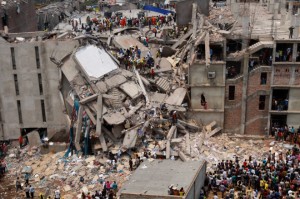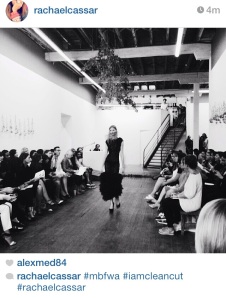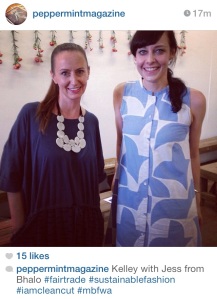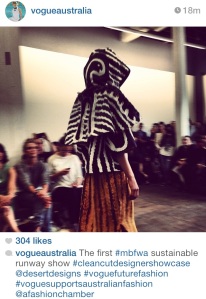I f you have taken an interest in the ethics of the fashion industry in the past, you’ll be well aware of some of the impacts of Fast Fashion on the planet and its people. As Maddy Newman wrote in the wake of H&M’s Melbourne launch a few weeks back, “Fast fashion’s seductively low prices encourage us to buy things we don’t need (and sometimes don’t really want), with little regard for the enormous environmental and human costs of this rapid-fire supply chain that squeezes margin from those who are most vulnerable.”
f you have taken an interest in the ethics of the fashion industry in the past, you’ll be well aware of some of the impacts of Fast Fashion on the planet and its people. As Maddy Newman wrote in the wake of H&M’s Melbourne launch a few weeks back, “Fast fashion’s seductively low prices encourage us to buy things we don’t need (and sometimes don’t really want), with little regard for the enormous environmental and human costs of this rapid-fire supply chain that squeezes margin from those who are most vulnerable.”
What’s less clear is what can be done about it.
Changing the way we buy clothes isn’t as easy as choosing free range eggs at the supermarket. Especially when we have such a huge smorgasbord of cheap and easy wares to choose from. Spending money on fashion shouldn’t be like buying a burger: cheap, spontaneous, and consumed within minutes.
But the fashion game is changing, fast. With rapid advances in technology and global communications, trends move quickly. From catwalk to store within weeks, the notion of two seasons per year is virtually obsolete — and with fast fashion retailers like Top Shop releasing 300 new styles each week, competition is fierce. The game is now who can get the latest style out faster and cheaper than any other retailer.
On April 24 2013, the world watched in horror as the Rana Plaza garment factory in Bangladesh collapsed, killing 1,133 people and injuring over 2,500. Tomorrow is the one year anniversary of that tragedy, and Fashion Revolution’s #InsideOut campaign is asking you to ask the question: Who Made Your Clothes? The focus is on increasing transparency in the supply chain, and encouraging retailers and designers to consider the story of the clothes they are producing.
As consumers, where we choose to shop and what we choose to purchase can make a big difference in the supply chain story.
Buy Organic, Fair Trade, Or Second-Hand
I’m not talking about tea and chocolate here; organic cotton and fair trade clothing are viable, ethical alternatives to fast fashion.
The environmental footprint and social injustice that the production of our clothes leaves behind incriminates us all. Cotton is a lucrative crop that has a devastating effect on those involved in its harvest; using more insecticides and pesticides than any other crop, the production of cotton severely impacts the environment, affects food supply and results in illness, disease and birth defects. Shockingly there are 250 million children around the world estimated to be involved in the growing and harvesting of cotton. In Uzbekistan, children are taken from school each year to harvest cotton. Many die or suffer injuries working in tough conditions, and are poorly compensated for their labour, leaving them without an education or an income for their families.
Meanwhile, factories like Rana Plaza — which continue to be employed by most major Australian brands – exploit men, women and children to produce faster. These people work long hours, with little to no compensation. After the collapse, the Accord on Fire and Building Safety in Bangladesh was established, with the aim of ensuring all garment factories in the country were safe workplaces. While they have no plans to stop sourcing from Bangladesh, Target, Big-W, K-Mart and Cotton On were among the companies that signed on to the accord. (Best and Less and Just Group refused). For those who signed, it’s a good first step, but it doesn’t solve everything: these companies, and many other retailers, are not transparent in their supply chains, and without transparency it is impossible to know who has made our clothes and under what conditions.
The benefits of Fair Trade clothing means that there is a focus on what’s known as the triple bottom line, or the ‘3-Ps’: pro-people, pro-planet and pro-profit. Programs that work with vulnerable communities to teach them how to sew or create garments helps protect these people from being exploited or embedded in a cycle of poverty. When we shop organic and Fair Trade, we are placing our consumer dollar behind companies that add value to the farmers and artisans who make our clothes. We are ensuring that no child was involved in the manufacturing of our products, and we are working in partnership with producers, enabling communities to invest in environmental initiatives and establish community development programs.
Organic cotton is another solution, reducing water supply and taking 1.5 tonnes of CO2 per acre out of the atmosphere each year. When we pay a higher price for an organic t-shirt, farmers can invest it into organic farming, helping them to become financially and environmentally sustainable.
The Ethical Fashion Guide provides an insight into some of the brands we most commonly shop, helping us make more informed choices about where we spend our money. The more we shop ethically, the more likely companies will begin to make changes to their own supply chains.
Ethical fashion in Australia has become much more common place than a few years ago, meaning we no longer need to compromise too much on style or budget.
Here are a few of the best of Australia and New Zealand’s sustainable fashion labels, resources and market places:
Indigo Bazaar: a selection of organic and ethical labels
Alas The Label: sustainable sleepwear
Kowtow Clothing: Fair Trade and organic clothing
Lalesso: wonderful Fair Trade designs made in Kenya
Gorman Organics: beautifully designed and made organic items
Ethical Clothing Australia: a guide to ethical shopping in Australia
Red Threads: Red Cross op-shops around Australia with a boutique/vintage feel
Do you have your own recommendations? Take them to the comments section!
In the meantime, ask your favourite retailer who made your clothes, and get your friends thinking about who their consumer choices might be affecting. Our clothes tell a story. What do yours say about you.
Thursday April 24 is Fashion Revolution Day. Take a photo of yourself wearing your clothes inside out, and share it on social media with the hashtag #InsideOut. To find out more, head here.


